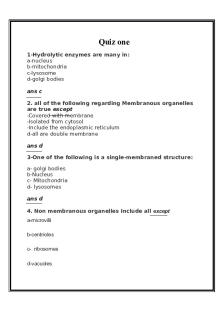Bio204r5 Plant Cell Organelles and Their Functions Worksheet PDF

| Title | Bio204r5 Plant Cell Organelles and Their Functions Worksheet |
|---|---|
| Course | Plant Physiology |
| Institution | University of Phoenix |
| Pages | 2 |
| File Size | 201.7 KB |
| File Type | |
| Total Downloads | 22 |
| Total Views | 157 |
Summary
Download Bio204r5 Plant Cell Organelles and Their Functions Worksheet PDF
Description
Plant Cell Organelles and Their Functions Worksheet BIO/204 Version 5
University of Phoenix Material Plant Cell Organelles and Their Functions Worksheet Review the “Cross Section of a Plant Cell” simulation. Write a 45- to 90-word response for each question. Question
Student response
What is the interdependent relationship between mitochondria and other organelles?
The mitochondria work with the glucose that’s stored in the cells and turns it into ATP which is an energy molecule that is needed for biochemical reactions to happen within the cell this molecule can be found in any life form.
What are the similarities and differences between the Golgi apparatus and the endoplasmic reticulum?
There are some fluid filled dishes in the Golgi apparatus where in the endoplasmic reticulum there is tubules and vesicles. Both have something to do with lipids the endoplasmic reticulum produces and consumes them while the Golgi apparatus stores or modifies them.
What is the function of the central vacuole? Why does a plant require this function?
The central vacuole reminds me of the human appendix as they both store poison and don’t really have much use but the central vacuole does more as it also stores salt and water pigments. The plant needs this part as it requires water for the cell to stay alive and have a place to put all the toxins that are introduced to them.
Describe the structure and function of chloroplasts. Include the terms inner membrane, outer membrane, stroma, thylakoid membranes, and grana. Include the functions of stroma and grana.
The structure of a chloroplast from this simulation to me looks like a cell within a cell which is ironic because the chloroplast has many different functions within it such as the stroma. The stroma is where carbon dioxide turns into glucose during photosynthesis and the grana produces ATP during photosynthesis
Explain the function of the smooth endoplasmic reticulum and the rough endoplasmic reticulum. How are their functions similar to those of the nucleus? How are they different?
Smooth ER’s have no ribosomes attached and the rough ER’s do. The function of the Smooth ER is to transport materials through the cell and the Rough ER has a special surface where ribosomes can attach to and synthesize proteins.
For covalent, ionic, and hydrogen bonds, describe a) each type of bond, b) which is the strongest and weakest and why, and c) which disassociate in water and why.
Ionic bonds are formed when two atoms have a big difference in electronegativity, ionic bond can disassociate in water because adding water would break the electronegativity. Covalent bonds are formed when two atoms have a very small amount of electronegativity difference, covalent is the strongest due to having a direct bond as the atoms balance. Hydrogen bonds are only formed when Oxygen, Hydrogen, or fluorine is involved together.
Compare exergonic and endergonic reactions.
Exergonic reactions are spontaneous chemical
Copyright © 2016, 2015 by University of Phoenix. All rights reserved.
1
Plant Cell Organelles and Their Functions Worksheet BIO/204 Version 5 Provide an example of each.
reactions where the energy level is lower than the reactants. Endergonic are non-spontaneous chemical reactions in which the energy level is higher than the reactant so in fact they are exact opposites of each other.
Discuss the similarities and differences between osmosis and diffusion. What are the driving forces behind each process? Why are membranes selectively permeable? How do they control what crosses them?
Diffusion is the movement of a chemical from one place to another whereas osmosis exclusively deals with transporting water across the membrane. They both equalize the concentration of solutions into the membrane.
What role does solute concentration play in osmosis? How does water’s chemical potential influence osmosis?
Water moves from within and turns low concentration of solute to high concentration of solute and this lowers the potential for water if done so.
Distinguish between osmotic pressure and potential. What organelle is related to osmotic potential? What organelle is related to osmotic pressure? What role do aquaporins play in cell membrane permeability?
They prevent the passage of anything coming in or out except water molecules and they are also known as water channels.
Copyright © 2016, 2015 by University of Phoenix. All rights reserved.
2...
Similar Free PDFs

Cell Biology Quiz CELL ORGANELLES
- 10 Pages

WS-Cell Organelles+ - Lab
- 5 Pages

Cell Organelles Review
- 5 Pages

Animal and plant cell lab
- 13 Pages
Popular Institutions
- Tinajero National High School - Annex
- Politeknik Caltex Riau
- Yokohama City University
- SGT University
- University of Al-Qadisiyah
- Divine Word College of Vigan
- Techniek College Rotterdam
- Universidade de Santiago
- Universiti Teknologi MARA Cawangan Johor Kampus Pasir Gudang
- Poltekkes Kemenkes Yogyakarta
- Baguio City National High School
- Colegio san marcos
- preparatoria uno
- Centro de Bachillerato Tecnológico Industrial y de Servicios No. 107
- Dalian Maritime University
- Quang Trung Secondary School
- Colegio Tecnológico en Informática
- Corporación Regional de Educación Superior
- Grupo CEDVA
- Dar Al Uloom University
- Centro de Estudios Preuniversitarios de la Universidad Nacional de Ingeniería
- 上智大学
- Aakash International School, Nuna Majara
- San Felipe Neri Catholic School
- Kang Chiao International School - New Taipei City
- Misamis Occidental National High School
- Institución Educativa Escuela Normal Juan Ladrilleros
- Kolehiyo ng Pantukan
- Batanes State College
- Instituto Continental
- Sekolah Menengah Kejuruan Kesehatan Kaltara (Tarakan)
- Colegio de La Inmaculada Concepcion - Cebu











